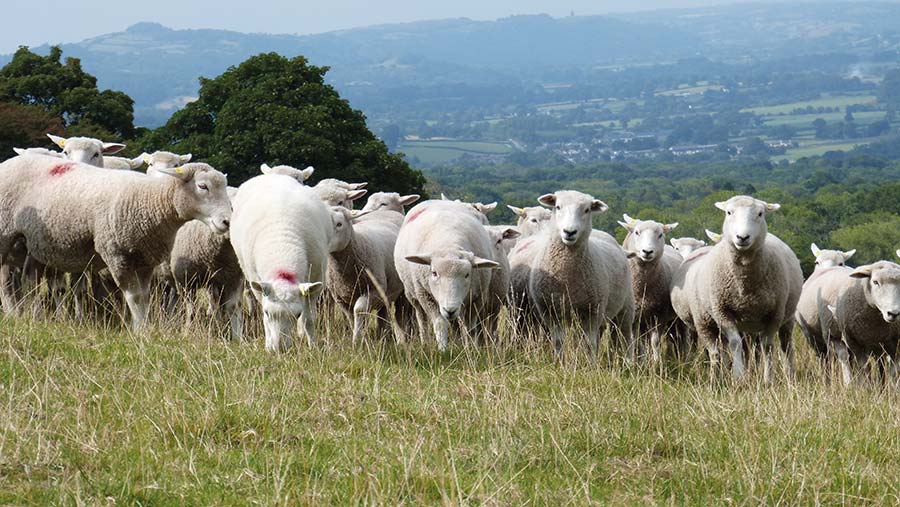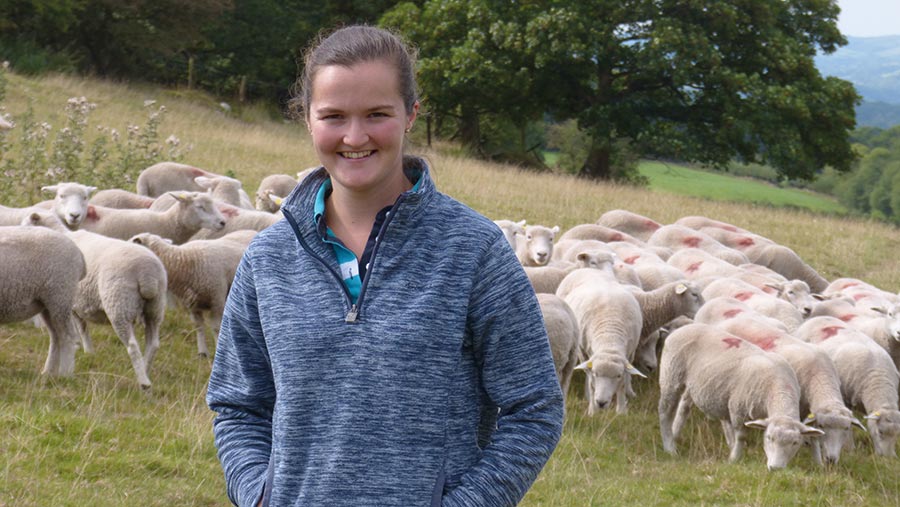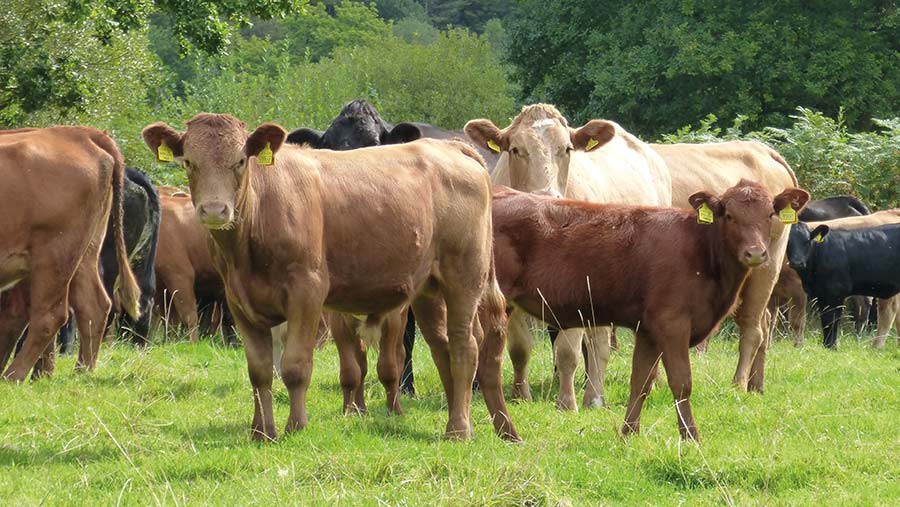How a Romney ram could solve labour issues for Welsh flock
 © MAG/Michael Priestley
© MAG/Michael Priestley A young farmer’s mission to breed low-input stock so she can manage 500 ewes and 80 cows by herself has been kick-started by a generous freebie.
Carmarthenshire beef and sheep farmer Carys Jones won a free Romney ram from the Kaiapoi flock last year and is impressed by the results so far.
She hopes the sheep system can emulate the farm’s suckler enterprise, which switched dairy-cross continental cows to Stabiliser genetics in 2015.
See also: Dorset outdoor lamber lifts scan 20% with Belclare
Miss Jones farms with grandfather Trevor at Carreg cyn ffyrdd, near Llandeilo, on the edge of the Black Mountain. She is trying to prepare the business for diminishing subsidies.
“I have changed the suckler genetics and every cow is at least 50% Stabiliser and far lower input than before,” explains Miss Jones.
“What I want to do with the sheep is try to breed the equivalent of a Stabiliser ewe and lamb outdoors, meaning apart from help on big yarding days, I will be able to manage the farm largely by myself.”
Farm facts
- 500 mostly improved Welsh Mountain ewes
- 60 Stabiliser suckler cows to bull this year
- 141ha (350 acres), with 80-100ha (200-250 acres) improved
- Ranging from 180-310m altitude
- Prime lambs sold liveweight through an agent
- Store cattle and breeding stock sold privately
- Charollais and New Zealand Sufftex terminal sires
- Ewes scan at 155% and rear 140%
Romney ram
The free tup was gifted by Hertfordshire Romney breeders Rob and Jo Hodgkins after Miss Jones successfully applied in a National Sheep Association competition.
Dubbed the Next Gene-eration Giveaway, the initiative was part of a pledge the Hodgkins made when making a funding bid to help cover the importation of six live rams with the Myomax muscling gene from New Zealand in 2019.
The importation received £20,000 from the Frank Parkinson Agricultural Trust and £3,000 from the Henry Plumb Foundation.
Miss Jones was one of six fortunate applicants from a pool of 40 who explained why they needed the ram and what they wanted to achieve in the sheep industry.
“I was attracted to Kaiapoi Romneys because of the amount of data behind them. They are good foragers and do well off very little inputs. They have the muscling gene, too, so should produce a decent carcass.
“When I drove over to pick him up, he just looked like a plain grass-fed ram, but he’s grown out since and he’s a much bigger tup now.”
Need for change
The business has common grazing rights for 600 ewes on the Black Mountain. However, because of a long-term endemic sheep-rustling problem in the area, the family only grazes the common for short periods.

Carys Jones © MAG/Michael Priestley
“Once the Glastir payment goes next year on the hill, we will probably take the sheep off as the risk of losing them is too high and there’s also disease risk such as worm resistance,” explains Miss Jones.
This means productivity at home must improve to keep the business thriving. The flock joined the Hybu Cig Cymru (HCC) hill ram scheme in 2018 to improve genetic merit after seeing rearing rates drop.
Miss Jones also hopes that labour at lambing can be minimised, so the family do not need to spend their holidays in the lambing shed.
Ram performance
In its first season, the Kaiapoi Romney ticked lots of boxes, explains Miss Jones:
- It tupped 52 sheep and got all in-lamb – the only tup with no empty ewes
- Ewes bred by him scanned at 157%, compared with an average of 150-155%
- Only one ewe needed a light pull at lambing
- Lambs were heavier at eight weeks (see “Weights of different lamb sire groups at eight weeks”) and at weaning off grass.
Weights of different lamb sire groups at eight weeks |
||
|
Breed |
Singles (kg) |
Twins (kg) |
|
Welsh Mountain |
24.7 (120 lambs) |
21.5 (269 lambs) |
|
Kaiapoi Romney |
25.1 (30 lambs) |
22.6 (43 lambs) |
|
Charollais |
22.3 (12 lambs) |
21.98 (45 lambs) |
|
New Zealand Sufftex |
22.8 (40 lambs) |
21.4 (47 lambs) |
The performance convinced her to buy a second tup and 100 shearling ewes from Kaiapoi this year.
This has allowed her to make the most of strong cull ewe prices and use her flock data to cull empty ewes and problem sheep.
Sheep system
The farm has historically lambed the cross-bred lambs and terminal sire lambs indoors and the pure Welsh Mountain ewes outside.
Ewe lambs have been sired by a home-bred Charmoise ram, and Charollais terminal sires have been used on ewes.
The plan now is to criss-cross the farm’s Welsh Mountain flock to breed replacements, using a performance-recorded Welsh Mountain ram and a Romney.
The Charmoise ram will still sire the ewe lambs and Primera and New Zealand Sufftexes will tup lower-index sheep as terminal sires.
The farm has been breeding and selling its own recorded rams through Prohill – run through HCC – since 2018.
“There are 183 rams in the Prohill sale this year and it should be possible to select a better ram from this group of breeders. There is data and the rams aren’t being forced, so they should be functional.”
Ewes will continue to have two cycles with the ram, lambing from 1 April, but outdoors. Outdoor lambing should save on a lot of straw and labour, says Miss Jones.
The aim will be to build sufficient grass covers by budgeting grass through the autumn and winter with the aid of fortnightly plate metering.
The Romney-, Prohill Welsh Mountain- and Primera-cross lambs should hopefully lamb outside and be checked twice a day.
Cattle system
Success with the cattle inspired Miss Jones to review the sheep system.
The herd has gone from calving through most of the year to calving in 12 weeks and rearing 95-100% on account of good fertility, easy calving, low mortality, and a few twins each year.
Previously, the cows were British Blue- and Limousin-cross cows out of dairy herds, and they needed lots of concentrate and assistance at calving.
Birthweights from the Stabilisers averaged 36kg this spring, and wintering yearling heifers outside on silage and a small amount of rearing nuts saved on feed costs. Adult cows now winter on haylage alone.
Average cow weight has dropped by 100-150kg to 650-700kg, meaning more cows can be stocked on the same land area.

© MAG/Michael Priestley
“If I am going to farm largely on my own, I don’t want to have heavy, laborious jobs like pulling calves. This has been eradicated in the cows, so I hope it [pulling lambs] can be in the sheep as well.
“Only one cow needed help calving this spring, which was an old continental cow.”
The farm’s high rainfall (1.6m/year normally) means outwintering on the land – which is peat over clay in areas – can lead to heavy poaching.
To enable expansion, the farm will have a new slurry store built so another 10-15 cows can be kept.
A slatted floor and a roof will be installed over the story, potentially allowing the farm to keep 50 cows alongside 500 ewes.
